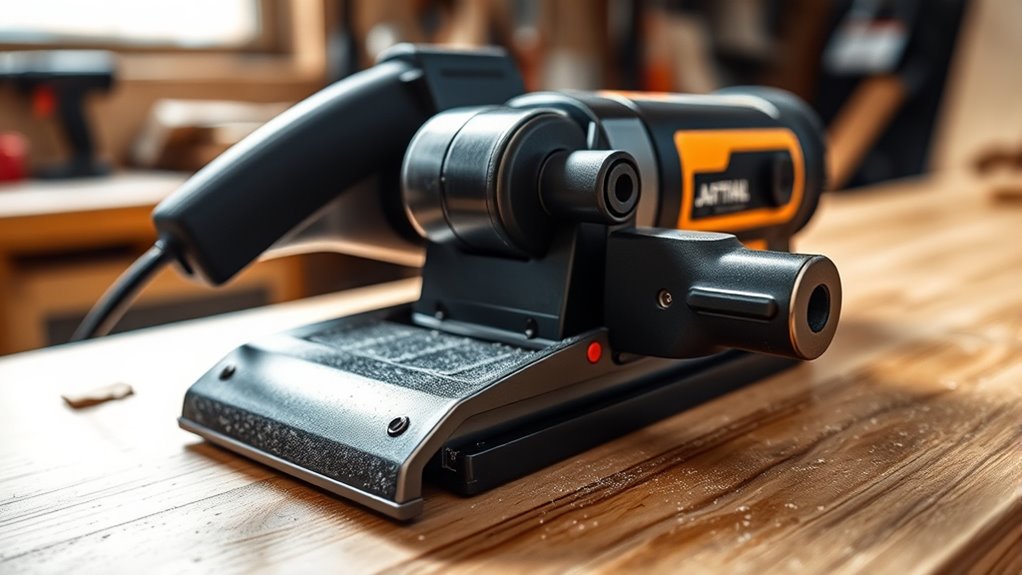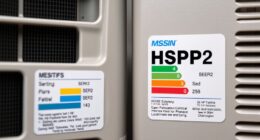If you’re looking for the 12 best belt sanders of 2025 for smooth and precise finishes, I recommend considering models with powerful brushless motors, adjustable speeds, and effective dust management, like the Makita 9403 or DEWALT cordless options for portability. Lightweight and ergonomic designs, such as those from SKIL and Jellas, make handling easier for longer projects. From heavy-duty to versatile dual-function models, there’s an excellent choice for every task — and you’ll discover more options and details as you continue exploring.
Key Takeaways
- Look for models with adjustable speed controls for precise surface finishing and material compatibility.
- Prioritize belt sanders with dust collection systems to maintain a clean workspace and improve finish quality.
- Consider lightweight, ergonomic designs for comfortable handling during extended use and detailed projects.
- Choose heavy-duty, brushless motor models for increased power, durability, and consistent performance on tough surfaces.
- Opt for versatile belt sizes and dual-function options (belt and bench sander) for greater project flexibility.
Jellas Belt Sander with Dust Bag (BS750-SD)
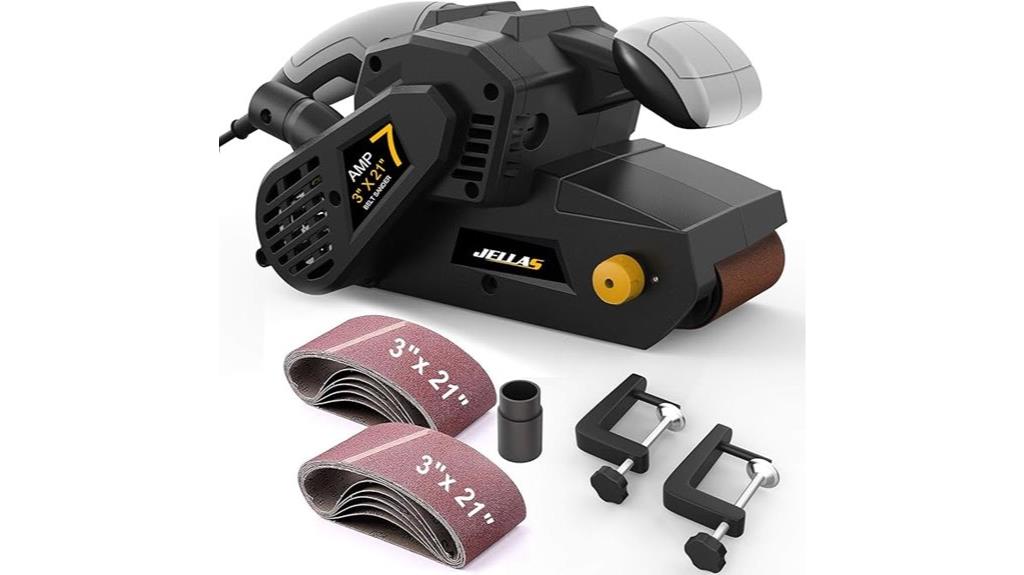
If you’re looking for a versatile belt sander that balances power, control, and affordability, the Jellas Belt Sander with Dust Bag (BS750-SD) is an excellent choice. It features a strong 7Amp motor, a lightweight design, and adjustable speed controls from 120 to 400 RPM, making it suitable for various projects. Its dual functionality allows use as both belt and bench sander, with included clamps for stability. The dust collection system works well, especially when connected to a shop vac, minimizing mess. Overall, it’s reliable, easy to handle, and perfect for woodworking, refinishing, or small DIY tasks.
Best For: DIY enthusiasts, woodworking beginners, and small project hobbyists seeking an affordable yet powerful belt sander with versatile functionality.
Pros:
- Strong 7Amp motor delivers reliable power for various sanding tasks
- Dual belt and bench sander functionality enhances versatility for different projects
- Effective dust collection system, especially when used with a shop vac, keeps work area cleaner
Cons:
- Small clamps may not fit larger workbenches or thicker materials
- Speed control can become less responsive at higher temperatures with extended use
- Dust bag durability issues reported by some users, requiring replacement over time
Metabo HPT Belt Sander (SB8V2)

The Metabo HPT Belt Sander (SB8V2) stands out as a top choice for professionals and serious DIYers who need raw power and durability. Its 9.0-amp, 1020-watt motor handles tough jobs like woodworking, metalworking, and surface prep with ease. The variable speed control offers precision, while the flush surface design ensures even sanding. Built with a sturdy metal frame and ergonomic grip, it’s designed for long-term use. The dust collection system, including a large bag and corner sanding feature, keeps your workspace cleaner. Despite some minor adjustments needed for belt tracking, it provides excellent performance at a competitive price, backed by a 5-year warranty.
Best For: professional woodworkers, metalworkers, and serious DIYers seeking a powerful, durable belt sander for heavy-duty applications.
Pros:
- Robust 9.0-amp motor delivers excellent power for tough jobs
- Variable speed control allows precise material removal and finishing
- Solid metal frame and ergonomic design support long-term, comfortable use
Cons:
- Belt tracking adjustment can be awkward and may require patience
- Dust collection system, while effective, can interfere during operation
- Small belt release lever and odd belt clamp may be fiddly for some users
3×18 Inch Sanding Belts Kit (12 Pcs) with Grits 40/60/80/120 for Woodworking and Metal
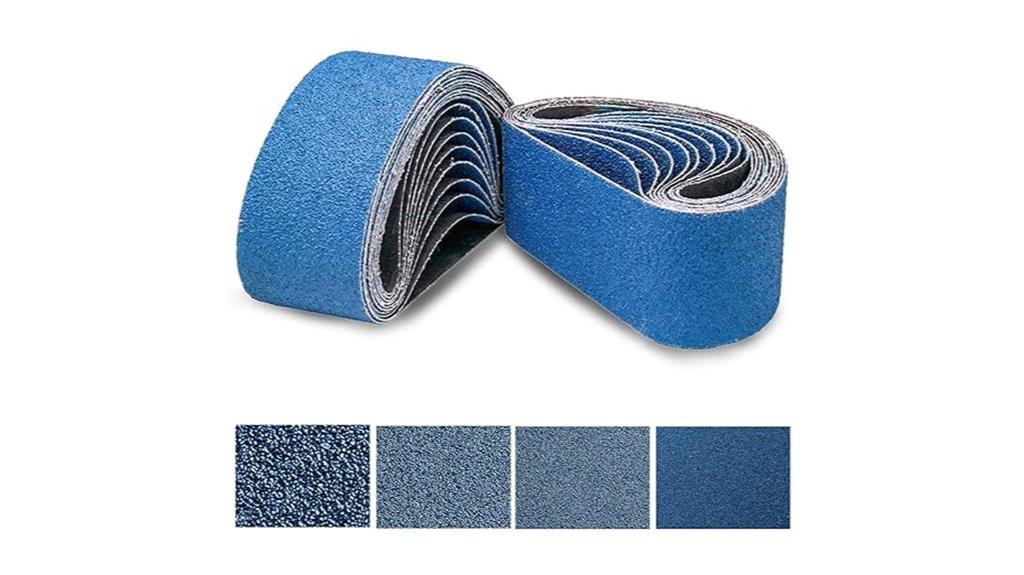
This 3×18 inch sanding belts kit stands out as an excellent choice for both DIY enthusiasts and professionals who need versatile, durable abrasives for woodworking and metalworking projects. It includes 12 belts with grit sizes 40, 60, 80, and 120, suitable for removing rust, paint, and burrs across various materials. Made from blue zirconia particles, these belts offer sharpness and longevity, resisting tearing and heat buildup. Compatible with most standard belt sanders, they deliver consistent performance, especially during heavy-duty tasks. Their seamless construction and solid joints ensure smooth operation and durability, making them a reliable, cost-effective option for a wide range of sanding needs.
Best For: DIY enthusiasts and professionals seeking versatile, durable sanding belts for woodworking and metalworking projects.
Pros:
- Made from high-quality blue zirconia particles for sharpness and long lifespan
- Compatible with most standard belt sanders, suitable for heavy-duty tasks
- Seamless design with solid joint construction ensures smooth operation and durability
Cons:
- Some users reported the 120 grit belts being oversized, reducing compatibility with certain sanders
- Grit wear may vary depending on material and usage intensity
- The belts may be less suitable for very fine finishing tasks compared to finer abrasives
SKIL 6 Amp 3×18 Belt Sander with Pressure Control – 7510-01
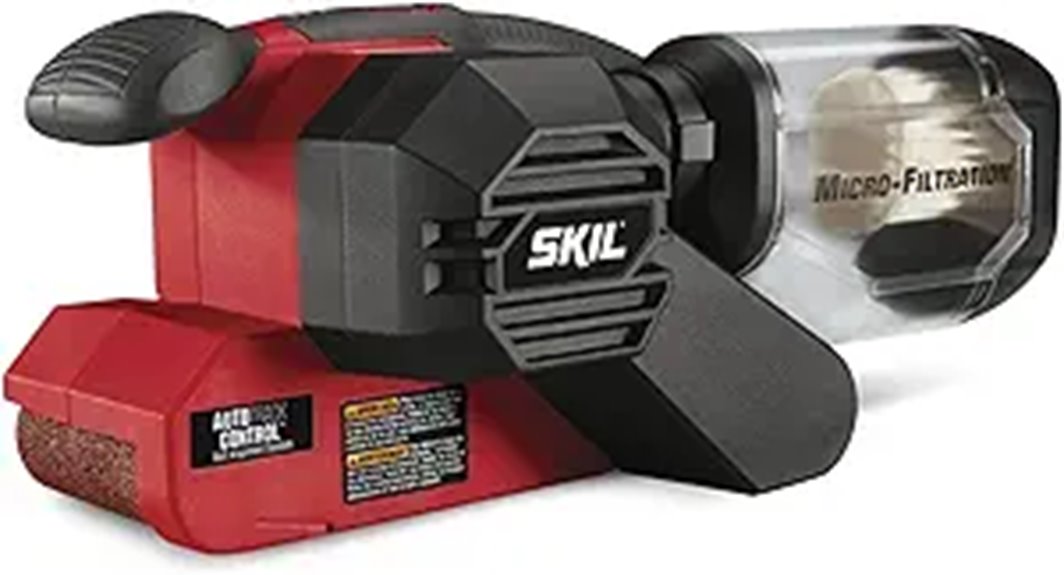
For DIYers and woodworking enthusiasts seeking reliable power and precision, the SKIL 6 Amp 3×18 Belt Sander with Pressure Control (7510-01) stands out as an excellent choice. Its 6-amp motor handles various wood surfaces effortlessly, while the pressure control technology warns me when I’m applying too much force, protecting the belt and extending its lifespan. The auto track belt alignment keeps the belt centered, and flush edge sanding allows me to reach edges easily. Weighing just over 5 pounds, it’s comfortable to handle for prolonged use. Plus, the dust collection system improves cleanliness, making this sander a versatile, user-friendly tool for multiple projects.
Best For: DIYers, hobbyists, and woodworking professionals seeking a reliable, versatile belt sander for light to medium projects with precision and ease of use.
Pros:
- Powerful 6 Amp motor effectively handles various wood surfaces and finishes
- Pressure control technology helps extend belt life by warning against excessive force
- Compact, lightweight design with ergonomic grip ensures comfortable handling during extended use
Cons:
- Dust collector can fill quickly, requiring frequent emptying during longer tasks
- Belt changing can be challenging due to limited slack in the belt tensioning system
- Slightly heavier weight than some users prefer, which may cause fatigue during prolonged use
Jellas 21-Inch Belt Sander with Dust Bag
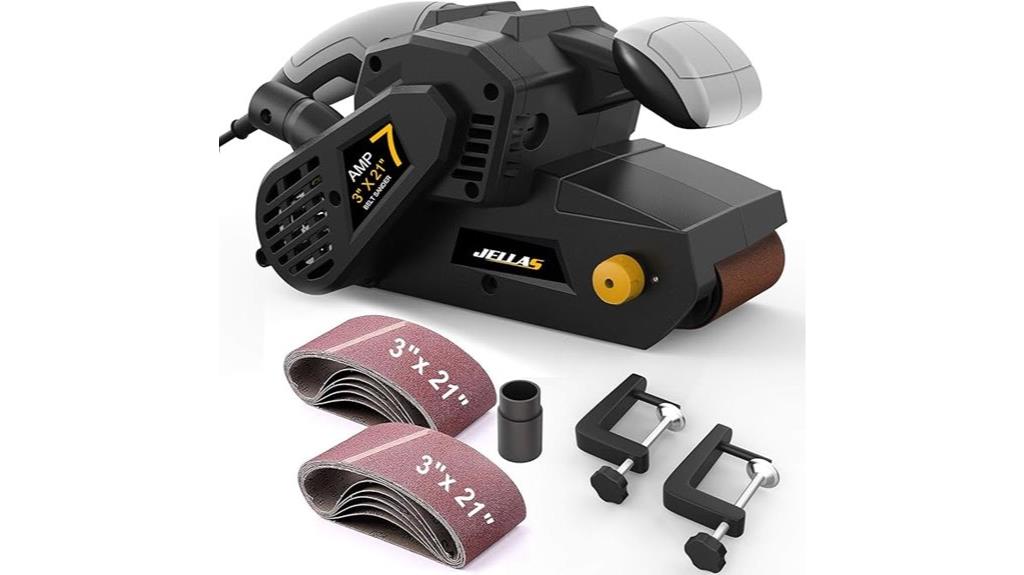
If you’re seeking a versatile belt sander that combines power and precision, the Jellas 21-Inch Belt Sander with Dust Bag stands out as an excellent choice. Its 7Amp motor and variable-speed control (120-400 RPM) make it adaptable for various projects, from woodworking to refinishing. It doubles as a belt and bench sander, thanks to metal clamps that turn it into a stationary tool. The dust collection system effectively minimizes mess, especially when connected to a shop vac. Lightweight at just 9.6 pounds, it’s easy to maneuver. Overall, this sander offers strong performance, multiple grit belts, and user-friendly features, making it a reliable choice for both pros and DIY enthusiasts.
Best For: DIY enthusiasts and professionals seeking a versatile, lightweight belt sander for woodworking, refinishing, and small projects.
Pros:
- Powerful 7Amp motor with adjustable speed for versatile applications
- Dual functionality as both belt and bench sander with included clamps
- Effective dust collection system that reduces mess and prolongs tool life
Cons:
- Small clamps may not fit larger workbenches or thicker materials
- Speed control can become less responsive at higher temperatures during extended use
- Dust bag durability issues reported by some users, requiring careful handling
DEWALT 20V MAX* Belt Sander, Cordless, Brushless, Tool Only (DCW220B)
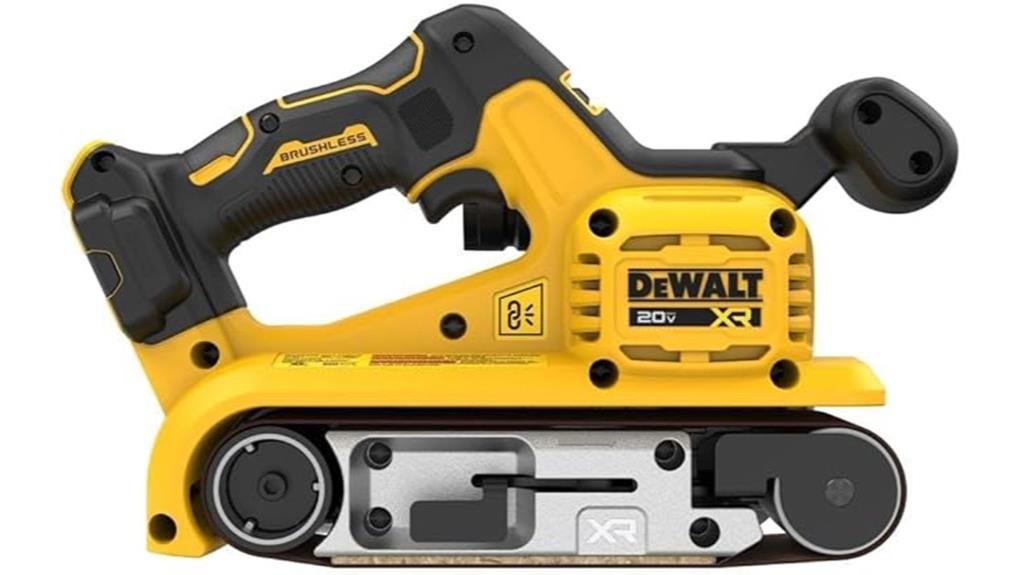
The DEWALT 20V MAX* XR Belt Sander (DCW220B) stands out as an ideal choice for professionals and serious DIYers who need powerful, cordless sanding performance. It boasts a brushless motor delivering up to 22% more power than corded models, with a 3-inch by 21-inch belt for large surface coverage. The adjustable belt speed via a variable trigger and 25-speed dial ensures precise control across materials. Lightweight at just 1 pound, it features quick belt changes, an ergonomic handle, and compatibility with DEWALT dust collection systems that capture up to 95% of dust. It’s perfect for demanding tasks where mobility and power are essential.
Best For: professional carpenters and serious DIYers seeking a portable, high-power belt sander for large surface areas and detailed sanding tasks.
Pros:
- Cordless design offers excellent mobility and convenience for on-site use
- Powerful brushless motor delivers up to 22% more power than corded models
- Easy, tool-free belt changes and adjustable speed for precise control
Cons:
- Battery life may limit extended continuous operation to around 30-40 minutes
- The sander is relatively heavy, which could cause fatigue during prolonged use or overhead work
- Dust collection system, while effective, may require additional accessories for optimal dust management
WEN 7.5-Amp 3-by-21-Inch Variable Speed Belt Sander
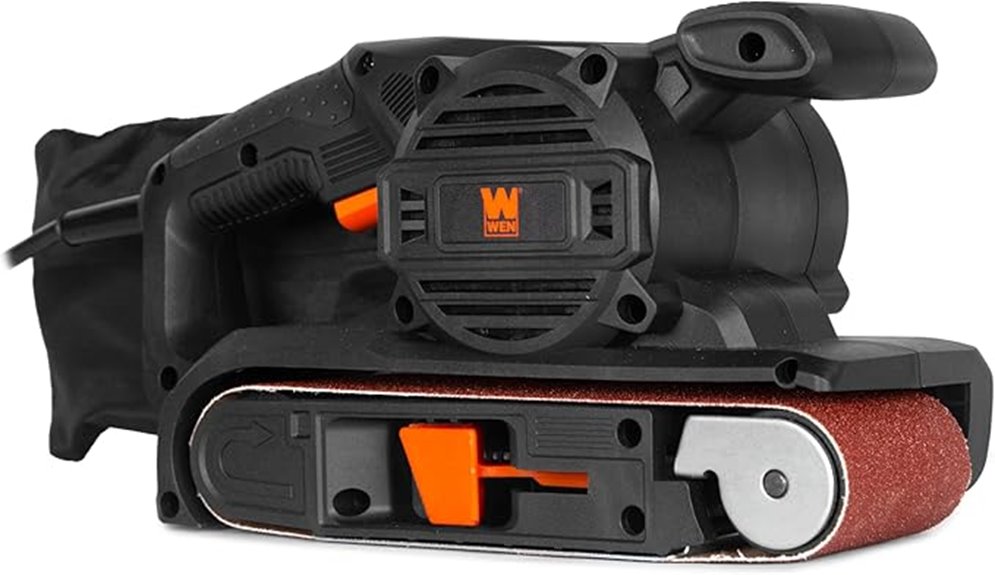
The WEN 7.5-Amp 3-by-21-Inch Variable Speed Belt Sander stands out as a versatile and budget-friendly choice for DIY enthusiasts and light to moderate professionals. Its 7.5-amp motor delivers adjustable speeds from 620 to 1200 FPM, allowing precise control for various tasks like surface smoothing, deburring, or paint stripping. Weighing just 6.4 pounds, it’s easy to handle for extended periods. Features like a lock-on switch, quick belt release, and onboard dust collection simplify operation and cleanup. With an included 80-grit belt and a two-year warranty, it offers reliable performance at an affordable price, making it a smart addition to any workshop.
Best For: DIY enthusiasts and light to moderate professional users seeking an affordable, versatile belt sander for surface smoothing, deburring, and paint removal.
Pros:
- Adjustable variable speed from 620 to 1200 FPM for precise control
- Lightweight design (6.4 pounds) for easy handling during extended use
- Quick-release belt tension lever and onboard dust collection for convenience
Cons:
- Some users report trigger sticking or safety concerns
- Plastic construction may raise durability questions for heavy-duty tasks
- Limited to coarse grit (80) belts, which may require additional abrasives for finer finishing
Makita 9403 4 x 24 Belt Sander, Teal
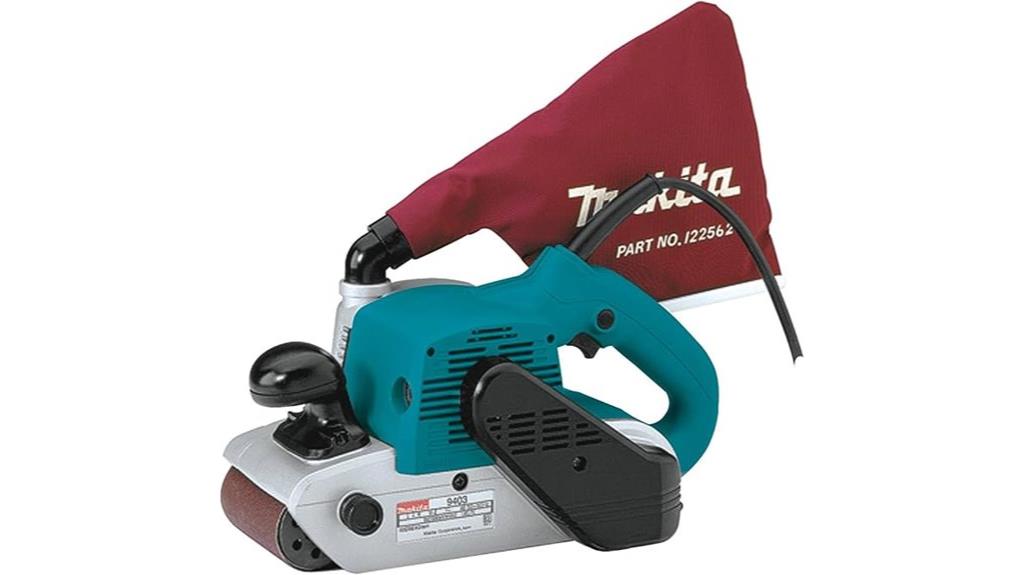
For professionals and serious DIYers demanding top-tier performance, the Makita 9403 4 x 24 Belt Sander stands out with its powerful 11 AMP motor and precise electronic speed control. It features a 4-inch wide belt that reaches speeds of 1,640 ft./min., enabling rapid material removal and smooth finishes. Designed for durability, it has a heavy-duty construction with dust-sealing bearings and a ceramic wear plate, ensuring long life. Its quiet operation at 84dB and balanced weight make it comfortable to handle. Perfect for large surface prep, wall finishing, or detailed work, this sander offers reliable, professional-grade results every time.
Best For: Professional woodworkers, carpenters, and serious DIYers seeking high-performance, durable belt sanding for large surfaces and detailed finishing.
Pros:
- Powerful 11 AMP motor with electronic speed control for efficient material removal
- Durable, heavy-duty construction with dust-sealing bearings and ceramic wear plate for longevity
- Quiet operation at 84dB with stable belt tracking and minimal vibration for comfortable use
Cons:
- Slightly heavier weight (13 pounds) may require more effort to handle for extended periods
- Belt changes, while straightforward, may require some initial practice for optimal tracking
- Heavy grit sanding (up to 80 grit) can fill the dust bag quickly, necessitating frequent emptying
Jellas 7Amp Belt Sander with Dust Bag and Power Cord
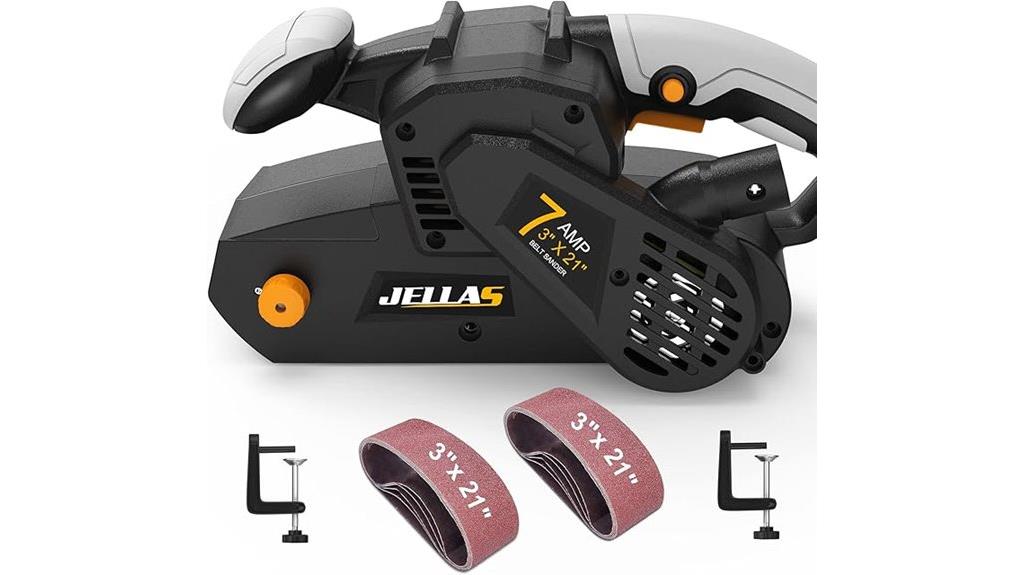
Looking for a versatile belt sander that can handle both bench and handheld tasks? The Jellas 7Amp Belt Sander offers that flexibility with its dual functionality. It features a powerful 7 Amp, 120V motor that spins the belt over 13 feet per second, with adjustable speeds from 120 to 400 rpm. The sander includes two metal C clamps, allowing it to be flipped and secured to a table for bench work, reducing fatigue with its lock-on button. It comes with 10 sanding belts in various grits, a detachable dust bag, and a 2-in-1 vacuum adapter for dust collection. Plus, it’s backed by a 2-year support warranty.
Best For: DIY enthusiasts and professionals seeking a versatile belt sander for both bench and handheld applications with adjustable speed and comprehensive dust collection features.
Pros:
- Dual functionality allows for easy switching between bench and handheld sanding tasks.
- Powerful 7 Amp motor with variable speed control adapts to various project needs.
- Comes with multiple grit sanding belts and an efficient dust collection system for cleaner workspaces.
Cons:
- May be heavier and bulkier when set up on a work table, requiring space and stability.
- The 2-year warranty and customer support might not cover all custom or accidental damages.
- Adjustable speed range (120-400 rpm) may not be sufficient for highly specialized or industrial-grade applications.
6 Pack 48-Inch Sanding Belts, 120 Grit Knife Sharpener Belts
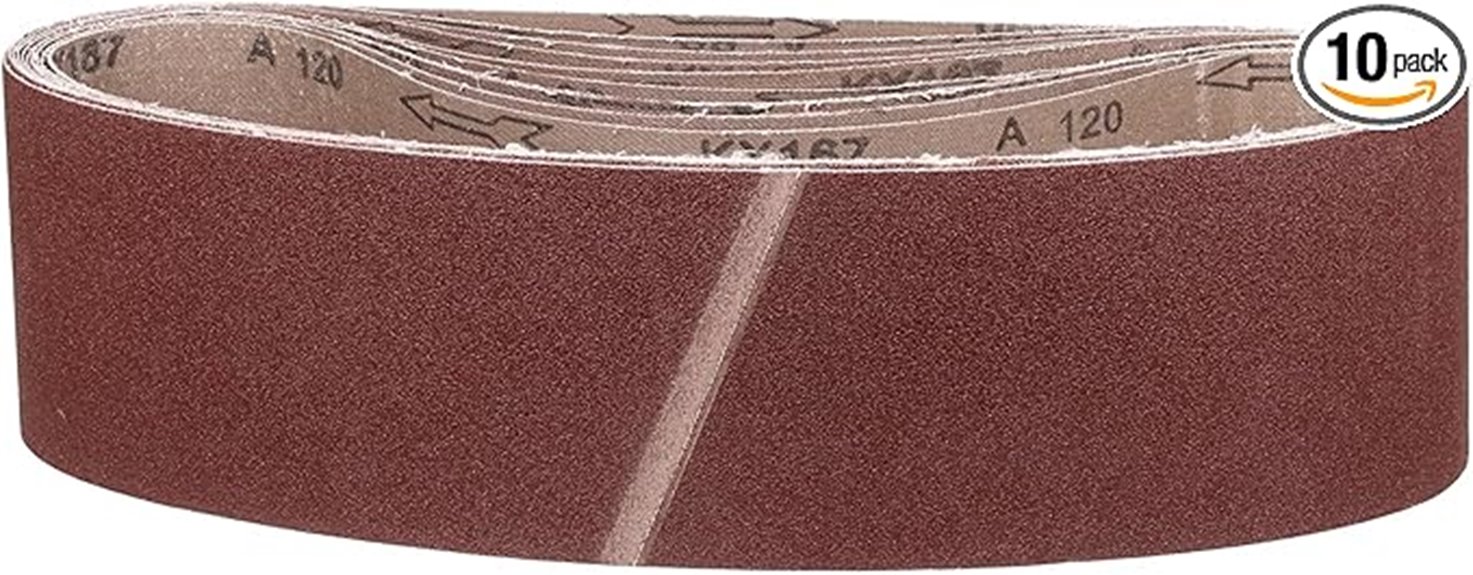
If you’re seeking reliable sanding belts that deliver consistent performance across various projects, the Pack 48-Inch Sanding Belts with 120 grit are an excellent choice. These belts come in a set of ten, designed specifically for belt sanders, with clear directional arrows to ensure proper use. Made from durable aluminum oxide, they resist heat and wear, making them suitable for tasks like knife sharpening, rust removal, and metal polishing. Their electrostatic bonding keeps abrasive particles firmly attached, preventing shedding during use. Whether working with wood, metal, or plastic, these belts provide smooth, efficient grinding, helping you achieve precise results every time.
Best For: DIY enthusiasts, woodworkers, and metalworkers seeking reliable, versatile sanding belts for sharpening, polishing, and surface finishing.
Pros:
- Durable aluminum oxide construction resists heat and wear for long-lasting use
- Electrostatic bonding prevents abrasive shedding, ensuring consistent performance
- Suitable for a wide range of materials including wood, metal, plastic, and stone
Cons:
- May require careful handling to avoid uneven wear or damage
- Not suitable for extremely heavy-duty industrial applications
- Proper alignment and tensioning are necessary to maximize belt lifespan
VEVOR Sanding Belts, 4 x 36-inch, 10PCS Zirconia Grits
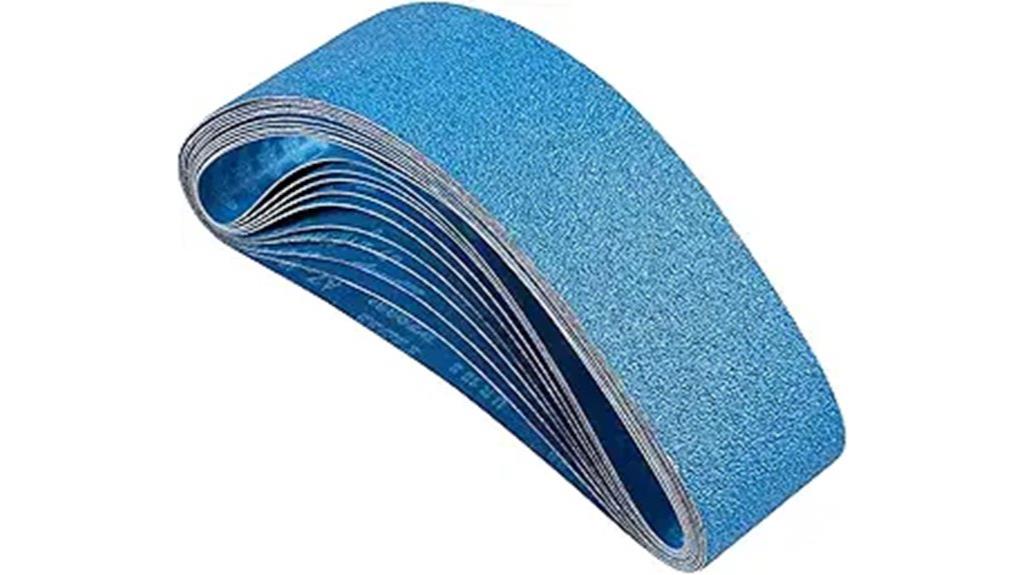
The VEVOR Sanding Belts, 4 x 36-inch, 10PCS Zirconia Grits, are designed for serious DIY enthusiasts and professionals who need reliable, durable belts for demanding grinding and polishing tasks. These belts feature heat-resistant zirconia abrasive particles, offering high hardness and excellent cutting performance on tough materials like stainless steel and nickel alloys. With a variety of grits—40, 60, 80, 120, and 240—they cover the full spectrum from coarse grinding to fine finishing. Easy to install on 4″ x 36″ belt sanders, they provide a seamless, hassle-free experience, making them perfect for both heavy-duty work and detailed polishing projects.
Best For: DIY enthusiasts and professionals seeking durable, versatile sanding belts for heavy-duty grinding, polishing, and finishing of tough materials like stainless steel and nickel alloys.
Pros:
- High-quality zirconia abrasive particles for excellent cutting performance and wear resistance
- Includes a wide range of grits (40-240) for versatile coarse to fine sanding
- Easy to install on standard 4″ x 36″ belt sanders with seamless, bi-directional tape joint
Cons:
- May be more expensive than lower-grade abrasive belts
- Not suitable for very delicate or soft materials that require gentler abrasives
- Requires a compatible belt sander for optimal use, limiting portability without the proper tool
CRAFTSMAN Electric 7 Amp Belt Sander, 3-in. x 21-in., Corded (CMEW213)
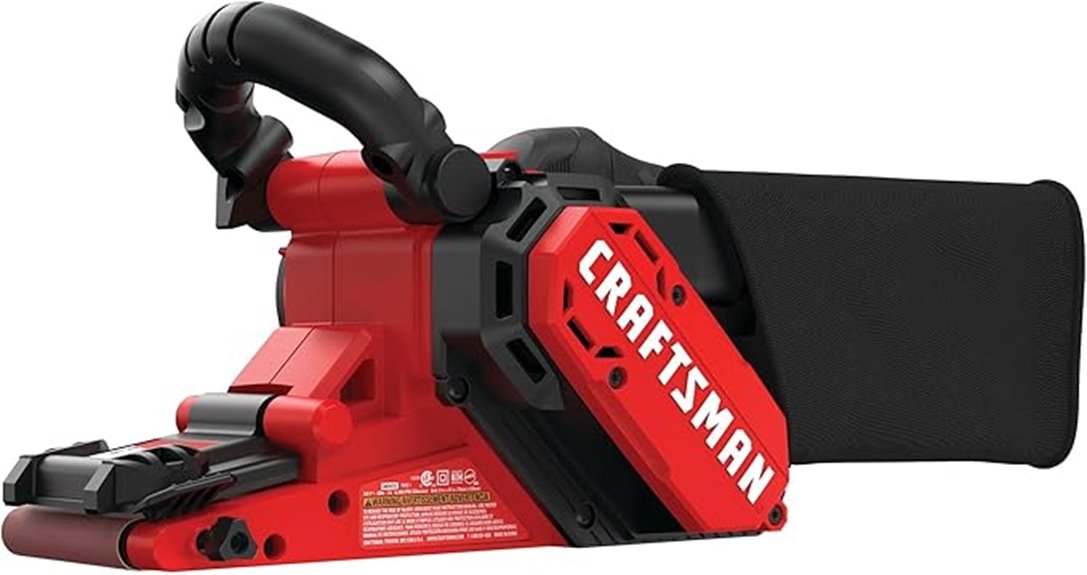
The CRAFTSMAN Electric 7 Amp Belt Sander (CMEW213) stands out for those seeking a powerful yet comfortable tool for close sanding tasks. Its 7.0 Amp motor delivers up to 800 FPM, ensuring fast material removal. The angled 3-in. x 21-in. belt allows precise work near surfaces. The adjustable handle positions and lightweight design (7.69 pounds) enhance control and reduce fatigue. Quick belt changes make it user-friendly, while the dust collection system is functional but not perfect. Overall, it’s a versatile, stylish sander suitable for various projects, praised for power, ease of use, and ergonomic features.
Best For: DIY enthusiasts and homeowners seeking a powerful, lightweight belt sander for close sanding and surface prep tasks.
Pros:
- Powerful 7 Amp motor with up to 800 FPM for efficient material removal
- Lightweight design (7.69 pounds) for easy maneuverability and reduced fatigue
- Quick-release lever and adjustable handle positions for user comfort and easy operation
Cons:
- Dust collection system is somewhat inefficient, leading to dust dispersal
- Air blasts toward the user during operation can be disruptive
- Difficult to achieve perfectly level surfaces on flat objects due to roller design
Factors to Consider When Choosing Belt Sanders
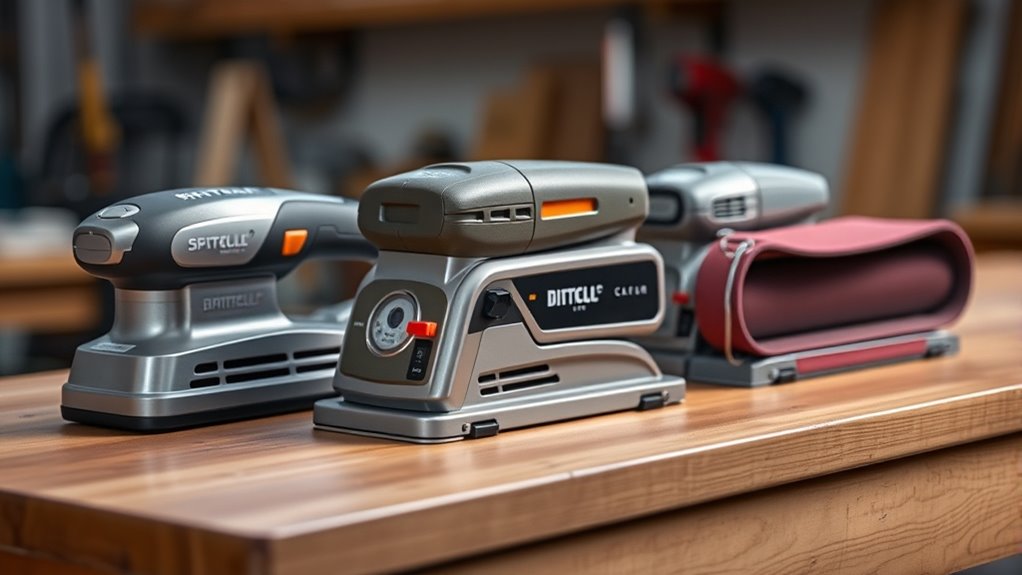
When choosing a belt sander, I focus on factors like power, belt size, and dust collection to get the best performance. It’s also important to contemplate features like variable speed and how comfortable the tool is to handle during extended use. By keeping these points in mind, you can find a sander that fits your project needs perfectly.
Power and Motor Type
Choosing the right belt sander depends heavily on its power and motor type, as these factors directly impact performance and usability. Higher motor wattage or amperage means more sanding power, making it easier to tackle tough materials. Brushless motors are more efficient and durable, offering longer runtimes and less maintenance than brushed motors. The choice between corded and cordless models affects portability and continuous operation; corded sanders provide unlimited runtime, while cordless ones offer greater mobility. Variable-speed motors let you adjust belt speed for different materials and tasks, improving control and finish quality. Additionally, a well-designed motor guarantees the sander can handle heavy-duty work without overheating, contributing to overall performance and longevity. These factors are essential for selecting a sander that meets your specific needs.
Belt Size Compatibility
Ensuring your belt sander supports the right belt size is essential for smooth operation and effective sanding. Check that the belt size matches your current belts or those you plan to buy, like 3×21 inches or 4×36 inches, to guarantee compatibility. It’s also important to verify that your sander supports the specific grit range and thickness of belts you’re considering, preventing fitting issues or belt slippage. Pay attention to the belt tracking system and tension mechanism, ensuring they can handle the belt size and keep the belt aligned during use. Additionally, larger belts often require more powerful motors for effective sanding without slipping or overheating. Using incompatible belt sizes can cause increased wear, breakage, or damage to your sander’s components, so careful matching is vital.
Dust Collection Efficiency
A high-quality dust collection system is essential for maintaining a clean and safe workspace while using a belt sander. Efficient systems can remove up to 95% of airborne dust when connected to a shop vac or dust extractor, considerably reducing health risks. Look for sanders with dust collection bags or ports that feature exhaust holes and secure attachments, preventing dust from escaping back into the workspace. Proper dust management also extends the sander’s lifespan by preventing buildup inside motor components. Keep in mind that dust collection effectiveness varies based on the type of dust bag or vacuum adapter used; some systems may need additional accessories for maximum performance. Investing in a sander with strong dust collection ensures a cleaner, safer, and more efficient sanding process.
Variable Speed Control
Variable speed control is a essential feature to take into account because it allows you to tailor the belt sander’s performance to different materials and tasks. Being able to adjust the belt’s rotation speed, typically from 120 to 400 RPM, gives you precise control over your work. This helps prevent damage to delicate surfaces and reduces the risk of burning or gouging, especially on softer woods or when finishing. A sander with variable speed also boosts versatility, letting you switch between aggressive material removal at higher speeds and detailed, fine sanding at lower speeds. Some models feature dials or knobs for easy, incremental adjustments, while others offer digital controls for even more precise settings. Overall, this feature enhances both safety and the quality of your finished project.
Ergonomics and Weight
Choosing a belt sander that feels comfortable to hold and operate can make a significant difference in your work. Lighter models, weighing between 5 to 10 pounds, help reduce fatigue during extended use, keeping you focused and steady. An ergonomic design, featuring padded grips and adjustable handles, improves control and comfort, making maneuvering easier. Proper weight distribution ensures even pressure across surfaces and prevents belt tracking issues. While heavier sanders offer stability, they can be cumbersome for prolonged handheld tasks, impacting maneuverability. Soft-grip handles and balanced weight distribution are key to reducing strain on your hands and wrists. Prioritizing ergonomics and appropriate weight helps you work more efficiently, with less fatigue, and achieves better finishing results.
Frequently Asked Questions
How Do Belt Sanders Differ From Orbital or Disc Sanders?
Belt sanders differ from orbital or disc sanders mainly in their sanding action. I find belt sanders use a continuous loop of abrasive that moves in a straight, aggressive motion, making them great for rapid material removal. Orbital sanders, on the other hand, move in small circles, providing a smoother finish. Disc sanders spin a disc, offering control and precision, perfect for detailed work and finishing.
What Safety Precautions Are Essential When Operating a Belt Sander?
When operating a belt sander, I always wear safety goggles to protect my eyes from dust and debris. I make sure to keep my hands clear of the moving belt and hold the tool firmly to prevent slips. I also work in a well-ventilated area and unplug the sander when changing belts or making adjustments. Staying alert and following these precautions keeps me safe and helps achieve a smooth finish.
Can Belt Sanders Be Used for Metal and Woodworking?
Yes, belt sanders can be used for both metal and woodworking, but you need to choose the right type and abrasive belt for each material. I recommend using a metal-specific belt for metalwork to prevent damage and guarantee safety. For woodworking, a softer grit works best. Always follow safety guidelines and adjust the sander settings according to the material you’re working on to achieve the best results.
What Maintenance Is Required for Belt Sanders?
Keeping your belt sander in top shape is like nurturing a good relationship. I regularly check and replace worn belts, clean dust and debris from vents, and lubricate moving parts to keep everything running smoothly. I also inspect the power cord for any damage and ensure the belt tension is just right. Proper maintenance not only extends its life but also makes certain you get the best, most precise results every time.
How Does Belt Tension Affect Sanding Performance?
Belt tension directly impacts sanding performance by ensuring the belt stays aligned and runs smoothly. If the tension’s too loose, the belt slips, causing uneven sanding and potential damage. On the other hand, too tight a tension can strain the motor and wear out components faster. I always check and adjust the tension regularly to maintain peak performance, resulting in a smoother, more precise finish on my projects.
Conclusion
So, if you’re serious about achieving the smoothest, most professional finish imaginable, these belt sanders are your secret weapons. They’ll turn rough, stubborn surfaces into silky perfection faster than you ever thought possible. Trust me, once you experience the power and precision of these tools, you’ll wonder how you ever worked without them. Don’t settle for anything less—grab one today and transform your projects into masterpieces!
